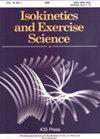Data repeatability for the Cosmed K4 b2 portable metabolic cart during non-steady state exercise
IF 0.7
4区 医学
Q4 ENGINEERING, BIOMEDICAL
引用次数: 0
Abstract
BACKGROUND:Portable metabolic carts are a popular tool to assess aerobic capacity and affirm many cardiorespiratory conditions. They may also measure strength training performance. Given their popularity and increased usage to assess strength training performance; their data accuracy and consistency are important to determine. OBJECTIVE:Measure Cosmed K4 b2 portable metabolic cart data repeatability from consecutive seated calf press workouts. METHODS: Fifteen women and twelve men did two workouts that began with a stationary cycling warm-up followed by calf presses. Gases were measured before the calf press portion of workouts to establish baseline VO2 and VCO2 values, as well as continually throughout and after the calf press protocol. Subjects were detached from the cart once gas values returned to baseline after workouts concluded. In addition to VO2 and VCO2, repeatability was quantified for: breaths per minute, tidal volume, ventilation, O2 uptake relative to body mass, expired O2 and CO2 fractions, percent fat and carbohydrate utilization, METS and total energy cost. Mean and peak values per variable were analyzed. Repeatability was assessed separately for male and female data, as well as with values pooled, by the following: intraclass correlation coefficients, eta squared, limits of agreement, coefficient of variation and smallest real difference percent. RESULTS: Per variable, repeatability values across workouts were low. Female intraclass correlation coefficient mean values were more repeatable for variables related to gas measurements, yet male data were generally more repeatable for those related to substrate usage. CONCLUSIONS: Results for some repeatability indices were influenced by measurement magnitude. Peak values were predictably less repeatable than those for mean values. Most smallest real differences percent scores are so high they were rendered irrelevant or meaningless to determine true differences among paired values. Results suggest low data repeatability that are likely appropriate and realistic for the exercise protocol, hardware and intensity examined.Cosmed k4b2便携式代谢车在非稳态运动中数据的可重复性
背景:便携式代谢车是评估有氧能力和确认许多心肺疾病的流行工具。它们也可以衡量力量训练的表现。鉴于它们的流行和越来越多的使用来评估力量训练的表现;确定它们的数据准确性和一致性非常重要。目的:测量Cosmed K4 b2便携式代谢车数据的可重复性,从连续的坐姿小腿按压训练。方法:15名女性和12名男性进行了两次锻炼,首先是固定自行车热身,然后是小腿按压。在训练的小腿按压部分之前测量气体,以建立基线VO2和VCO2值,以及在小腿按压方案期间和之后持续测量气体。锻炼结束后,一旦气体值恢复到基线,受试者就离开推车。除VO2和VCO2外,可重复性还被量化为:每分钟呼吸次数、潮汐量、通气量、相对于身体质量的O2吸收量、到期O2和CO2分数、脂肪和碳水化合物利用率百分比、METS和总能量成本。分析每个变量的平均值和峰值。对男性和女性数据的可重复性分别进行评估,并通过以下方法合并评估:类内相关系数、平方、一致限、变异系数和最小实际差异百分比。结果:每个变量的重复性值都很低。对于与气体测量相关的变量,女性的类内相关系数平均值更具可重复性,而对于与底物使用相关的变量,男性的数据通常更具可重复性。结论:部分重复性指标的结果受测量量值的影响。可预测的是,峰值的可重复性低于平均值。大多数最小实际差异百分比分数如此之高,以至于无法确定配对值之间的真实差异。结果表明,对于所检查的运动方案、硬件和强度而言,低数据可重复性可能是合适的和现实的。
本文章由计算机程序翻译,如有差异,请以英文原文为准。
求助全文
约1分钟内获得全文
求助全文
来源期刊

Isokinetics and Exercise Science
医学-工程:生物医学
CiteScore
1.20
自引率
14.30%
发文量
37
审稿时长
>12 weeks
期刊介绍:
Isokinetics and Exercise Science (IES) is an international journal devoted to the study of theoretical and applied aspects of human muscle performance. Since isokinetic dynamometry constitutes the major tool in this area, the journal takes a particular interest in exploring the considerable potential of this technology.
IES publishes studies associated with the methodology of muscle performance especially with respect to the issues of reproducibility and validity of testing, description of normal and pathological mechanical parameters which are derivable from muscle testing, applications in basic research topics such as motor learning paradigms and electromyography. The journal also publishes studies on applications in clinical settings and technical aspects of the various measurement systems employed in human muscle performance research.
The journal welcomes submissions in the form of research papers, reviews, case studies and technical reports from professionals in the fields of sports medicine, orthopaedic and neurological rehabilitation and exercise physiology.
 求助内容:
求助内容: 应助结果提醒方式:
应助结果提醒方式:


